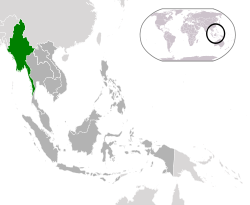US-Myanmar Relations: A Print Media Analysis
By IPCS
By Tanika Chadha
Myanmar, after the 2011 general elections in which U Thein Sein emerged as the country’s president, has been on an apparent steady road to reforms. This new face of the country has led the US to resume measures to reinvigorate US-Myanmar relations after the break in relations in 1988. This commentary will bring out the various aspects in which easing has occurred between November 2011 and June 2012 through a media survey.
Easing measures

US President Barack Obama recently announced that the US will ease the long-standing economic sanctions and restrictions imposed on investments and trade with Myanmar. The US had imposed these restrictions in 1997 due to issues concerning money laundering and political instability in Myanmar (US Moves toward Normalizing Relations with Myanmar, The New York Times, 4 April 2012). American companies are now permitted, starting June 2012, to provide financial services and make investments in new businesses as well as old ones in Myanmar. However, to ensure that this entrance of new money in the country does not lead to human rights violations, stringent checks have been put in place by the US government.
However, human rights activists and organizations are criticizing the US for rewarding Myanmar too quickly. (US and EU demand an end to violence between Burmese Buddhists and Muslims, Asia News, 12 June 2012). A former political prisoner and now head of the US Campaign for Myanmar in Washington, Aung Din, stated that while the strengthening of relations must continue, if it is done too quickly or too generously, it will undermine democratic forces in the country (US moves towards normalizing relations with Myanmar, The New York Times, 4 April 2012).
Also it is important to note that the sanction measures are covered by five federal laws and four presidential executive orders of the US and the process of removing sanctions on some sectors will take more than a year. (Myanmar hopes for US sanctions move to boost economy, Reuters, 17 May 2012).
Apart from the economic front, the US is also trying to boost its relations with Myanmar on other platforms. For instance, after the US Secretary of State Hilary Clinton visited Myanmar in 2011, the US government’s level of representation in Myanmar was elevated to the former ambassadorial status, which had been downgraded to the Charge d’Affaires rank in 1990. To this effect, President Obama has now appointed an ambassador to Myanmar, the first in 22 years. (Barack Obama appoints Derek Mitchell as first US ambassador to Myanmar, The Guardian, 17 May 2012).
It was also evident from Panetta’s speech at the Shangri-La dialogue in Singapore in June 2012 that the US is likely to improve military ties with Myanmar. He, however, made it clear that the US will not build bases and establish permanent power but would instead be interested in helping the country build its own military capabilities (Panetta: US open to improving military ties with Myanmar if reforms there continue, The Washington Post, 2 June 2012)
American reasons to rebuild relations with Myanmar
The entry of Aung San Suu Kyi into Myanmar’s parliament, after her party, the National League for Democracy (NLD) won 43 seats in the by-elections and her cordial rapport with the President, U Thein Sein, is seen as a positive development in Myanmar. It is believed not only in Myanmar but also in the international community that Suu Kyi’s presence in parliament will lead Myanmar on the road to recovery, with human rights and economic reforms in place. Myanmar is now a developing economy, and with political stability in the country, it will open up vast opportunities for the US to expand its import market.
Rebuilding ties with Myanmar, would allow the US to remake American diplomacy in the Asia-Pacific region. It would allow the US to strategically balance China’s influence by reducing Myanmar’s economic and diplomatic dependency on China. This would also give the US better access into the Bay of Bengal and maintain a presence in the region. In some ways, the rebuilding of relations with Myanmar is a late success story of the Obama administration’s early policy to engage with threats to the US. (US to renew Myanmar ties in light of reforms, The New York Times, 13 January 2012).
In opposition to these positive responses from the US and Myanmar and their efforts to warm bilateral relations as reported in the media, responses by the Chinese government’s responses are highly negative. When most of the international community had cut-off Myanmar during the late 1980s, China had continued to engage with the country and provide aid to it. An article in The Daily Star states “China has no resistance toward Myanmar seeking (an) improved relationship with the West, but it will not accept this while seeing its interests stamped on,” suggesting that China is nervous about the recent developments in US-Myanmar relations (Is China nervous as Myanmar looks west?, The Daily Star, 10 December 2011).
Tanika Chadha
Research Intern, IPCS
email: [email protected]
